A Slightly Obsessed Genre Special!
OVERVIEW
Back in 2013 I started a weekly, self-imposed discipline of movie write-ups on my Facebook page. My intent—besides meagerly attempting, admittedly, to self-justify half a lifetime of obsessive movie-watching—was to find a format for writing about movies that is both entertaining and informative. Basically, I thought that if I could in any way pique a theoretical reader’s interest in classic movies or movie history, then I would consider the modest venture a rousing success.
Over this four week period, then, I’ll be rolling out the very first from these “series” on classic movies which I’ve here re-named “American Genres.” Identifying four distinct, uniquely homegrown categories of American filmmaking, I trace the chronology—in terms of convention and thematic content, mainly, but also in terms of their historical development—through eight “key” examples from each chosen genre.
While by no means an exhaustive survey or a rigorously-academic analysis, these are rather brief, hopefully engaging and accessible essays—written from the vantage of being a movie ‘enthusiast’ as opposed to a ‘writer’ or ‘critic’—on some of my personal favorite movies.
INTRO: MUSICALS!
Musicals: Its Heyday
Having dealt, not too summarily one hopes, with my all-time favorite genre of Classic Hollywood filmmaking, the Screwball Comedy, I think it’s only logical to move on to a genre with which I have had a bit more of a checkered history.
I love musicals. But I didn’t always. As a kid, when our mother forced us to watch such immortal classics as On the Town (1949) or Singin’ in the Rain (1952), I’d think, “Why are these people singing and dancing for no reason? It’s not real.”
But then I grew up and realized that 99.9% of what you see in the movies isn’t real either. In a musical, at least, the singing and dancing people seem to be having more fun, even when they don’t have a reason.
So ‘reality,’ far as I’m concerned, can go to blazes. (So, thanks, Mom!)
Obviously, or not, there were no musicals back in the days of the silent movie, so it took the introduction of a fully-synchronized soundtrack to make the musical even possible. Indeed, the first ‘talkie,’ 1927’s The Jazz Singer, WAS a musical, and when you actually *heard* the great Al Jolson calling out his famous catchphrase, “Hold on! Hold on, folks! You ain’t heard nothin’ yet!”—before breaking into a rousing, hip-swaying, fist-whistling chorus of “Toot Toot Tootsie”—you knew he wasn’t lying. The American Movie Musical was born.
For the first entries here, I’ll be concentrating on the Golden Age of the Classical Hollywood musical; highlighting one notable film from the period stretching from 1927 to the mid-60s, roughly, when the musical reigned at the box office before virtually “disappearing”—or, as I’ll put it in the next entries, “hiding in plain sight.” Stay tuned! In the meantime, folks, “Gotta dance! Gotta dance! Gotttaaaa daaaannccee!”
Musicals: Post-Magic
From outsized super productions based on successful Broadway shows to Disney animated feature films, the movie musical is still very much with us: Chicago (2002), The Phantom of the Opera(2004), Dreamgirls (2006), High School Musical (2006), The Princess and the Frog (2009),Tangled (2010), Les Miserables (2012), Frozen (2013), Into the Woods (2014)… the list goes on. And then there’s the inevitable dramatizations of the life of popular musicians: such “musical biopics” include Ray (2004), Walk the Line (2005), and, most recently, Love & Mercy (2014) and Straight Outta Compton (2015).
Many of these are fine and worthy films, but I believe a dedicated moviegoer—to say nothing of a slightly obsessed movie-watcher—would be hard-pressed to discover the classical movie elements—the high gloss and sheen of Fred Astaire and Ginger Rogers in Top Hat (1935), the Technicolor dreamscapes of Yolanda and the Thief (1945), the energy and exuberance of Seven Brides for Seven Brothers(1954)—in ‘properties’ that have been overproduced, market-researched, and test-focused to a fare-thee-well.
As such, the latter part of my discussion of movie musicals—bringing us from the 1970s to more-or-less the present day—will focus on those distinct qualities more, shall we say, ‘agreeable’ to the classic movie fan in films made after the movie musical, in effect (and for reasons discussed below), “died.”
Or did it?
A select few movie musicals–many not even explicitly categorized thus–have demonstrated in more recent years that the “magic” may not have gone out of the colorful, boards-bursting, rafters-raising dreamscape of what was once the most vital and “alive” genre of American filmmaking.
I. 42ND STREET (1933, Warner Bros., dir. Lloyd Bacon)
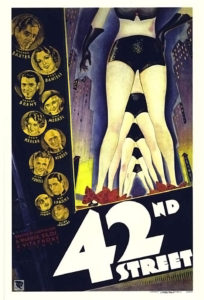 BOOK
BOOK
“Jones & Barry are putting on a show!” Yes, the “Angels of Broadway” (Ned Sparks, Robert McWade) have raised the moolah to put 200 performers and stagehands back to work during the darkest days of the Depression. Well, long as “Pretty Lady” star “Dorothy Brock” (Bebe Daniels) can string along pot-bellied millionaire investor “Abner Dillon” (Guy Kibbee), that is, and convince the old cluck that she isn’t hung up on her ex-vaudeville partner “Pat Denning” (George Brent)… But not to worry, folks, as Jones & Barry have secured the services of the great director “Julian Marsh” (Warner Baxter), who once had 3 shows running at once down the Great White Way. That was a few years ago, though, and even the greats are feeling the pinch of these desperate times. (“You ever hear of Wall Street?”) Still, even sick, tired, and broke, Marsh can pack ‘em in, and he’ll give it his all to make “Pretty Lady” the Second Coming on Broadway—or die trying. But when top-billed Brock breaks an ankle just before the first performance it’ll take a Marsh Miracle to save the production from doom. Which is when Marsh plucks a young hoofer named “Peggy Sawyer” (Ruby Keeler) from the chorus line to headline his show: “Sawyer, you’re going out a youngster, but you’ve got to come out a star!” Improbable? Sure, but hey, this is Broadway-by-way-of-Hollywood!
SONGS
One of the things that made old musicals truly great is that studios had the wherewithal to actually keep the most popular songwriters of the day on their payroll, writing songs exclusively for the movies. Irving Berlin, George Gershwin, and Jerome Kern were among the many great composers who signed exclusive contracts with studios like RKO, MGM, and Paramount. At Warner Brothers in the ’30s, it was Harry Warren & Al Dubin, whose music for 42nd Street was the pair’s very first score for the studio. Every number (“You’re Getting To Be a Habit With Me,” “Shuffle Off To Buffalo,” “Young And Healthy,” and the title song, “42nd Street”) is a bona-fide classic—and even when sung by nasal-voiced Ruby Keeler simply cannot be ruined! (Modern audiences might need a little warming up to the syrupy tones of Dick Powell—playing “juvenile lead, Billy Lawler”—as well, who would later be much better as a tough guy noir-hero in the ’40s.) For their very next movie, Gold Diggers of 1933, Warren & Dubin wrote “We’re In The Money (The Gold Digger’s Song),” which with its savage irony practically became an inescapable anthem for the Great Depression.
STAGE
Also brought on for the first time at Warner Brothers was choreographer Busby Berkeley, of whom it is absolutely no understatement to say singlehandedly invented the visual forms and conventions of the Classic Hollywood Musical. (Overhead shot of girls in skimpy attire rhythmically writhing in bizarre geometric patterns? Yup, that’s Berkeley.) 42nd Street in particular has an early variation on what would become a signature visual motif for Berkeley: a camera tracking along the ground between the outstretched legs of a long line of chorus girls. (As homage to Berkeley, The Coen Brothers famously substituted the chorus line for a bowling lane during a musical dream sequence in The Big Lebowski.) If nothing else, and for better or worse, the casual enthusiasm for the female form shown in these early musicals, exhibited by a distinctly heterosexual male-POV like Berkeley’s, certainly puts the lie to the unfair stereotype that one needs to be a woman (or a gay male) in order to enjoy a good musical!
CURTAIN
What with the songwriters and choreographer referenced above, you might have noticed a lot of ‘firsts’ being mentioned. 42nd Street was certainly Warner Brothers’ bid—under the aegis of producers Daryl F. Zanuck and Hal B. Wallis—for crafting THE ultimate movie musical, entirely divorced from the stagebound, static quality of previous song and dance revues, and as visceral, exciting, and urgent as the teeming hustle and bustle of a New York City street scene. (If nothing else, just look-up the titular “42nd Street” number sometime on YouTube or somewheres. It’s a doozy.) The backstage musical quickly became the stuff of cliché, but try to keep in mind that 42nd Street, along with its immediate successors (Footlight Parade, Dames, the Gold Diggers movies), INVENTED what later became conventions. As such, I suppose one might argue 42nd Street was actually the progenitor of legend!
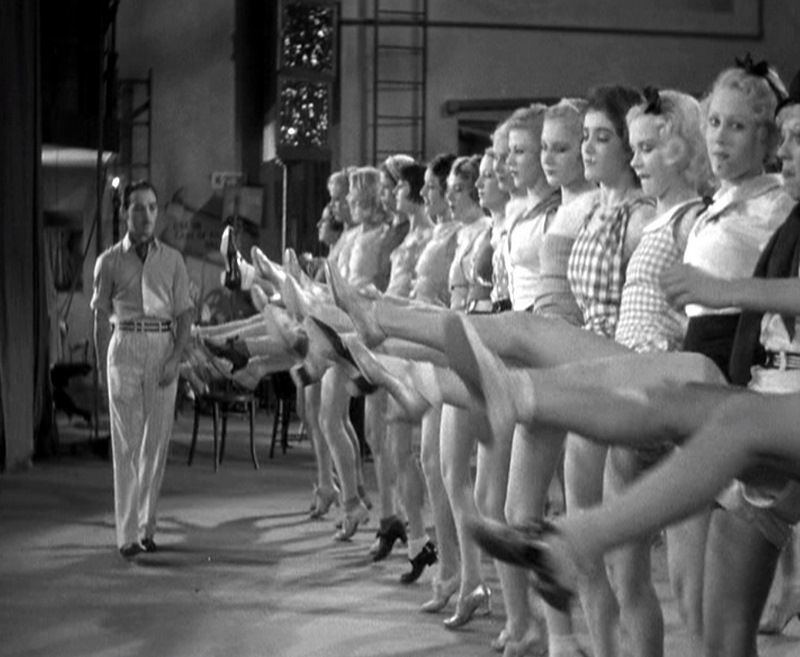
II. CABIN IN THE SKY (1943, MGM, dir. Vincente Minnelli)
 BOOK
BOOK
Pity poor “Petunia”! (Ethel Waters) Married to no-account “Little Joe” (Eddie Anderson), she cooks, cleans, and scrubs the whole day through while he lounges on a hammock by day and shoots craps by night. And it’s by the latter that Little Joe soon gets in trouble with the boys who hang around “Jim Henry’s Paradise,” being fatally shot one evening by “Domino Johnson” (John William Sublett) for not paying his gambling debts. But Petunia is in the good graces of The Lord and He naturally sends his top angel, “The General” (Kenneth Spencer), in answer to her fervent prayers. Little Joe is saved, but only on the condition that he redeem himself in just 6 months—or risk eternal damnation. The latter is represented by “Lucifer Jr.” (Rex Ingram) and his minions (Mantan Moreland, Willie Best, Louis Armstrong), and Satan’s Son sure as, um, ‘heck’ ain’t gonna let one of Pappy’s most ardent followers turn his back on a life of sin for the greener pastures of salvation. Enter “Georgia Brown” (Lena Horne), as sweet as sin’s temptation, whose silky, serpent charms make for Lucifer Jr.’s best ally against man’s constancy. Will Little Joe remain devoted to his Petunia, or will Sweet Georgia Brown lay claim to his soul?
MUSIC
Vernon Duke wrote the music for the original 1940 Broadway production, which introduced such hits as “Taking a Chance on Love,” “Ain’t It the Truth,” and the title song. For the movie, MGM commissioned Harold Arlen and E.Y. Harburg (the songwriters for The Wizard of Oz) to come up with a ‘plaintive piece’ for Ethel Waters and the result was “Happiness is a Thing Called Joe”—later popularized by Ella Fitzgerald, Peggy Lee, and many others. Otherwise, you’ve got just about every top Black performer of the time—from stage/opera singer Spencer to jazz and blues greats like Duke Ellington and Ethel Waters—making their inestimable contribution to a musical that more than lives up to the nightclub of song and legend calling itself “Paradise.”
STAGE
Vincente Minnelli, in his first Hollywood movie, brought the stage show to MGM under the aegis of (former song lyricist) Arthur Freed, with the full resources of the famed “Freed Unit” at his disposal. Possibly one of the most accomplished debuts in film history, Minnelli’s sure hand is evident from the first frame, mooring the more fantastic elements of the original play and musical to the starker, workaday realities of the characters and setting. When you’ve got performers like Lena Horne and John W. “Bubbles” Sublett—particularly magnetic during his ‘sweep & slide’ tap dancing to the old standard, “Shine”—you really can’t go wrong, but Minnelli, Freed & Co. give them the best possible showcase here.
CURTAIN
An All-Black Musical was a tough sell in 1943. Particularly in Hollywood, and MORE particularly at MGM. Major studios in the past had tried similar experiments—most notably King Vidor’s 1929 independent production of Hallelujah! (which MGM only distributed) and Warner Brothers’ production of the Marc Connelly musical Green Pastures in 1936—but never had Leo the Lion’s Roar preceded a film featuring a cast of all-Black actors and performers. The “Rolls Royce” of film studios stood to lose not only revenue—especially when a good third of the country wouldn’t even exhibit the movie—but also its reputation of providing “wholesome, family-oriented entertainment.” Of course, Freed & Co. proved the naysayers wrong and Cabin in the Sky became one of MGM’s biggest successes in 1943. For its time, I think it’s pretty groundbreaking but I suppose everyone watching the movie today will have to decide for themselves whether it’s ultimately more respectful or jarring in its (musical) depiction of African American culture. In any event, I think you’ll be pleasantly surprised, and more possibly quite impressed, that such a movie even exists.
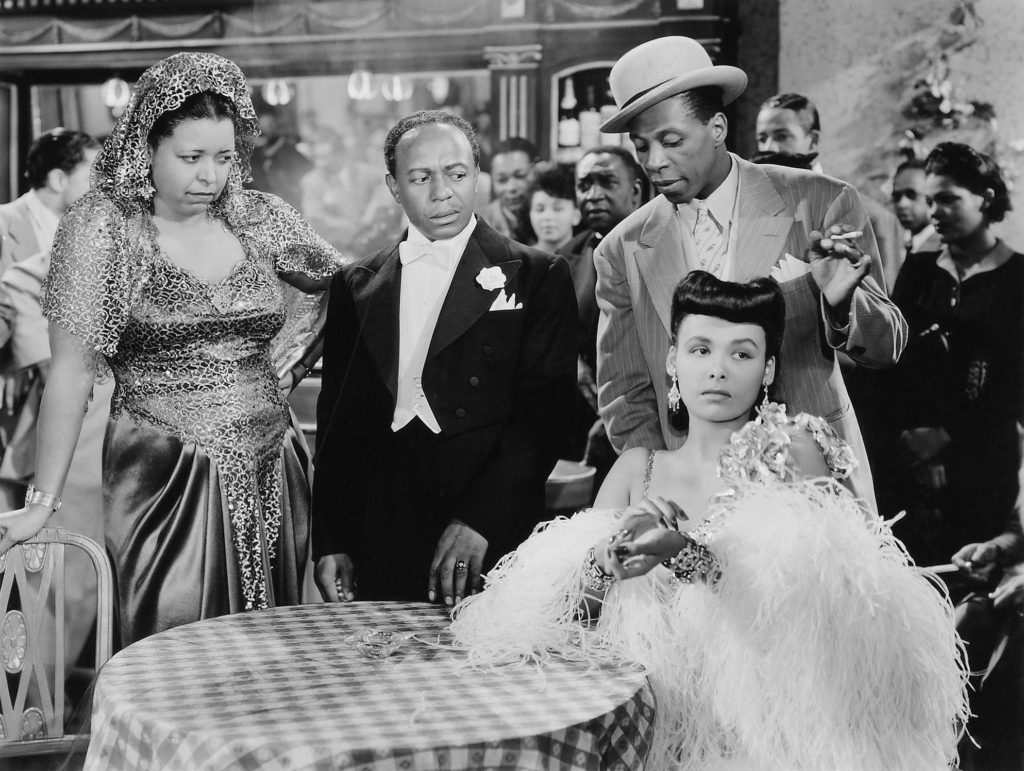
III. A STAR IS BORN (1954, Warner Brothers, dir. George Cukor)
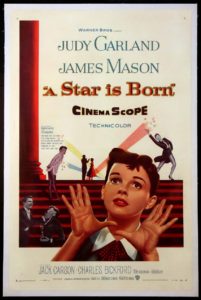 BOOK
BOOK
“Norman Maine” (James Mason), washed-up and alcoholic star of yesteryear, arrives at a Hollywood benefit washed-up and drunk, and is saved from embarrassing himself further when he stumbles on stage in the middle of an act by the quick wits of a young singer named “Esther Blodgett” (Judy Garland). The pair hit it off, and Maine quickly recognizes young Blodgett’s great talent. Re-named “Vicki Lester,” Maine sponsors his new discovery at his studio, where Ms. Lester soon becomes a great musical star. Even as her star rises, and his star fades, Norman Maine and Vicki Lester (or Ernest Gubbins and Esther Blodgett) throw their lot together in life through marriage, but the passing conjunction of two stars proves unequal to the harsh spotlight of celebrity and the demands of stardom. Realizing he’s dragging her career down, Maine comes to a fateful decision early one morning on the beach outside their Hollywood bungalow, watching the waves crash against the shore…
MUSIC
Harold Arlen & Ira Gershwin wrote five new songs—including “The Man Who Got Away,” “Here’s What I’m Here For,” and “Someone at Last”—for this musical remake, first filmed as a straight drama by director William Wellman in 1937, of the Classic Hollywood story, all of which later became signature tunes for Garland in the latter part of her career. Leonard Gershe (with uncredited music by Roger Edens) wrote the story-song “Born in a Trunk,” which ingeniously incorporates great old standards like “Swanee,” “I’ll Get By” and “You Took Advantage of Me” (with a nice joking use of “My Melancholy Baby”) in the cheeky telling of Vicki Lester’s film-within-a-film “musical biography.”
STAGE
The music is definitely part of the drama here, every performance piece being fully integrated into the narrative. In other words, a musical that actually takes place in “reality,” with every song Garland sings/performs being performed for a “real” audience in the movie—as in the case of the “It’s a New World” number, for one character in the movie—or, as one of Vicki Lester’s filmed/exhibited musical numbers. Hard to explain, maybe, but this is one musical where characters aren’t randomly breaking into song: here at least, there’s always a “reason”!
CURTAIN
As I mentioned, this musical is a remake of an earlier movie which itself was inspired by a still-earlier movie, also directed by George Cukor, called What Price Hollywood? (1932). But in the annals of Hollywood there’s nothing quite like this Sid Luft-produced, Cukor-directed, Garland-starring extravaganza we have here. Shot in Technicolor and CinemaScope, this is the silver screen’s first “intimate epic” and with its brilliant staging and vibrant use of color is on a short-list of movies I’d give up a year or two of life for to actually see in a big theatre. Well, maybe someday!
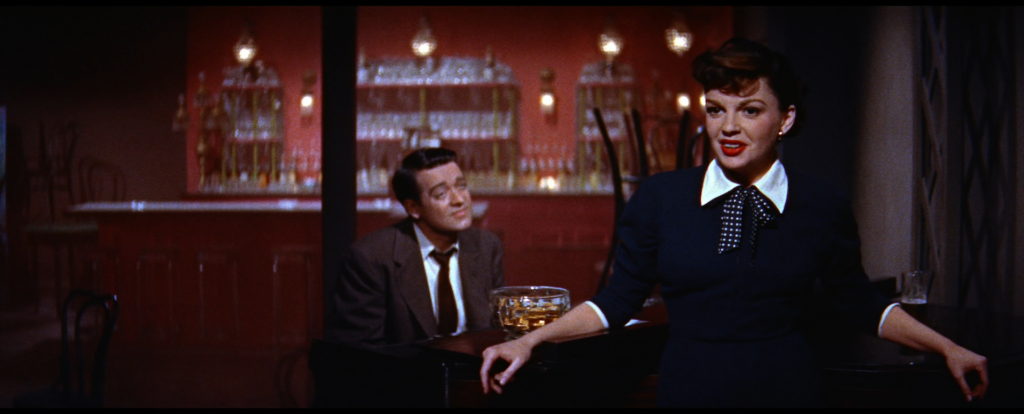
IV. MARY POPPINS (1964, Walt Disney Productions, dir. Robert Stevenson)
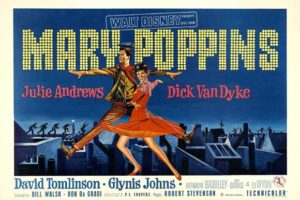 BOOK
BOOK
The Banks’ children, “Jane and Michael” (Karen Dotrice, Mathew Garber), have run off from their latest nanny, “Katie Nanna” (Elsa Lanchester), who promptly quits in exasperation. Nanny-less once more, and ignoring Jane and Michael’s request for a nanny who “plays games” and possesses “rosy cheeks,” “Mr. and Mrs. Banks” (David Tomlinson, Glynis Johns) place their own advertisement in The Timeswhich is answered by a formidable formation of frumpy and severe-looking middle-aged women. A mysterious wind from the east blows them all away and down floats umbrella-wielding “Mary Poppins” (Julie Andrews) from the heavens… Clearly the only suitable candidate for the job! Oft-accompanied by Cockney jack-of-all-trades, “Bert” (Dick Van Dyke), Mary Poppins treats the children to various adventures such as cleaning the nursery, a jolly holiday inside a street painting, a tea party on a ceiling, and a visit to the chimneysweep’s paradise atop the smoky rooftops of London. Also, through Mary Poppins’ magical influence, Jane and Michael’s distracted and over-busy parents see the error of their ways—namely, not paying enough attention to their children—and soon they’re all off having kite-flying adventures of their very own. Her job well done, Mary Poppins opens her umbrella once more and wistfully floats back to the heavens aloft the westerly wind.
MUSIC
Richard & Robert Sherman, known as the “Sherman Brothers,” were Walt Disney’s personal songwriting team from the late ’50s onwards, and wrote many a wonderful score for Disney movies during the ’60s and ’70s. The songs from Mary Poppins, all 16 of ‘em (“Spoonful of Sugar,” “Chim Chim Cher-ee,” “I Love to Laugh” etc. etc. etc.), are undoubtedly their masterpiece and, of course, even introduced a certain word to the English language which gives you “something to say when you have nothing to say.” (For me, that’s pretty much always, so thanks, Sherman Bros… Andsupercalifragilisticexpialidocious to you, too!)
STAGE
Disney’s lifelong ambition was to successfully (and seamlessly) mix animation and live-action, as evidenced by his earliest “Alice Comedies” of the ’20s to later features like Song of the South (1946) and So Dear to my Heart (1949), and Mary Poppins represents the fruition of his technical know-how and story-sense. A small thing today, maybe, but Dick Van Dyke dancing with a line of animated penguins—and hoisting a leg over the head of one of ‘em, who quickly, um, ‘ducks’—marks a level of technical sophistication that was 40 years in the making!
CURTAIN
I’ve a pet theory, perhaps not entirely original, that there are certain movies—the original King Kong(1933) and The Wizard of Oz (1939) being good examples—that so successfully draw-on, or even exploit, the human imagination that a kid watching them for the first time is indelibly marked with their story and images. Disney seemed to have the magic touch for crafting such works of art—really, can anyone out there remember a time when he or she HADN’T seen, say, Snow White or Pinocchio?—and Mary Poppins was perhaps the high water mark of his vision.

V. ALL THAT JAZZ (1979, Columbia/Twentieth Century Fox, dir. Bob Fosse)
 Out of an entirely contrarian impulse, I’ve decided to pinpoint the exact moment the Classical Hollywood Musical “died.” (Or try to, at least.) So, in having covered the ’30s (42nd Street), the ’40s (Cabin in the Sky), the ’50s (A Star is Born), and the ’60s (Mary Poppins) with fairly representative examples, guess we’ll be moving on here to the ’70s. And just because there just wasn’t a whole heckuva lot of ‘em being made then, the ’70s are actually an interesting time to talk about musicals.
Out of an entirely contrarian impulse, I’ve decided to pinpoint the exact moment the Classical Hollywood Musical “died.” (Or try to, at least.) So, in having covered the ’30s (42nd Street), the ’40s (Cabin in the Sky), the ’50s (A Star is Born), and the ’60s (Mary Poppins) with fairly representative examples, guess we’ll be moving on here to the ’70s. And just because there just wasn’t a whole heckuva lot of ‘em being made then, the ’70s are actually an interesting time to talk about musicals.
Following the break-up of the major film studios in the mid-50s, the few musicals being produced in Hollywood by the ’60s were mainly those taken from surefire theatrical successes. West Side Story(1961), My Fair Lady (1964), The Sound of Music (1965) et al. already had built-in audiences from their long runs on Broadway so it was felt that creating 3-hour Super Musicals—complete with overture, intermission, and exit music—would replicate the experience of a Big Broadway Musical, thus luring audiences to theaters by can’t-miss movie ‘events.’ Fiddler on the Roof in 1971 was pretty much the last of these ‘roadshow’ productions before economic and cultural factors gave way to the smaller-scale, more personal style of filmmaking that marked the 1970s.
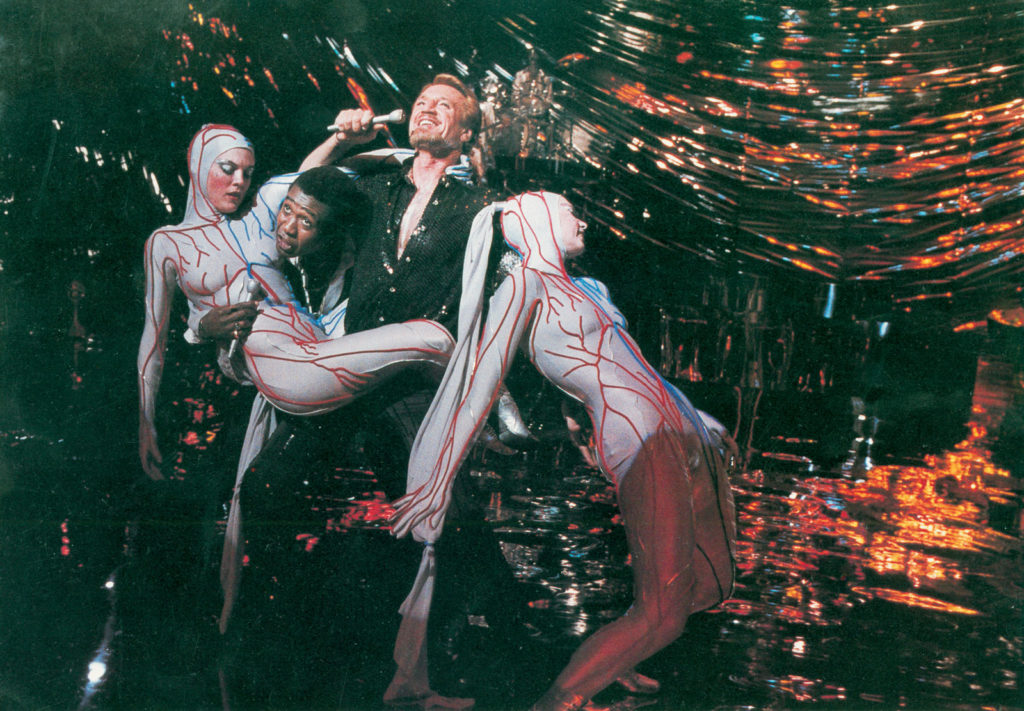
“It’s showtime, folks.”
Which brings us to Bob Fosse’s All That Jazz. Coming full circle from the musicals of the 1930s, we basically have an updated version of 42nd Street’s backstage rehearsal shenanigans and another relentlessly self-driven musical director in “Joe Gideon” (Roy Scheider). Here, though, the story is told entirely from the point of view of the director character: detailing his personal and artistic struggles as he simultaneously stages his next production, edits a movie, and attempts to balance the shambling elements—the ex-wife, “Audrey Paris” (Leland Palmer); the daughter, “Michelle” (Erzsebet Foldi); the girlfriend, “Kate Jagger” (Ann Reinking)—of his tattered personal life.
Set against musical fantasy sequences where Gideon reflects on the mistakes of his past—while literally flirting with the Angel of Death (Jessica Lange)—the film is a bracing, eccentric blend of classic musical tropes—big, splashy musical numbers, especially—with expressive, self-consciously surreal art-movie techniques. (I mean, where else are you going to see an elaborate musical number about open heart surgery?) As a late, almost post-entry to the genre, one can’t help thinking of the final images of this movie in terms of the classic movie musical’s last gasp…
But still, that ain’t all, folks!
VI. THIS IS SPINAL TAP (1984, Spinal Tap Prod., dir. Rob Reiner)
 The movie musical didn’t so much die in the ’80s as kinda go into hiding. (In plain sight, as it were.) Concert movies like The Decline of Western Civilization (1981) and Stop Making Sense (1984) incorporated a narrative structure to their ordering of musical numbers while action and comedy flicks like The Blues Brothers (1980) and Streets of Fire (1984) marked a return to the performance-based song and dance revues of two generations before. Even contemporary indie director Jim Jarmusch (Stranger Than Paradise [1984], Down By Law [1986], Mystery Train [1989]) and his predilection for casting cult musicians like John Lurie, Tom Waits, and Screamin’ Jay Hawkins in acting roles—while simultaneously scoring his movies with their music—seemed a canny meta-variation on administering a “spoonful of sugar” to make old-fashioned musical modulations go down a bit easier…
The movie musical didn’t so much die in the ’80s as kinda go into hiding. (In plain sight, as it were.) Concert movies like The Decline of Western Civilization (1981) and Stop Making Sense (1984) incorporated a narrative structure to their ordering of musical numbers while action and comedy flicks like The Blues Brothers (1980) and Streets of Fire (1984) marked a return to the performance-based song and dance revues of two generations before. Even contemporary indie director Jim Jarmusch (Stranger Than Paradise [1984], Down By Law [1986], Mystery Train [1989]) and his predilection for casting cult musicians like John Lurie, Tom Waits, and Screamin’ Jay Hawkins in acting roles—while simultaneously scoring his movies with their music—seemed a canny meta-variation on administering a “spoonful of sugar” to make old-fashioned musical modulations go down a bit easier…
Put simply, the 80s were a-rockin’.
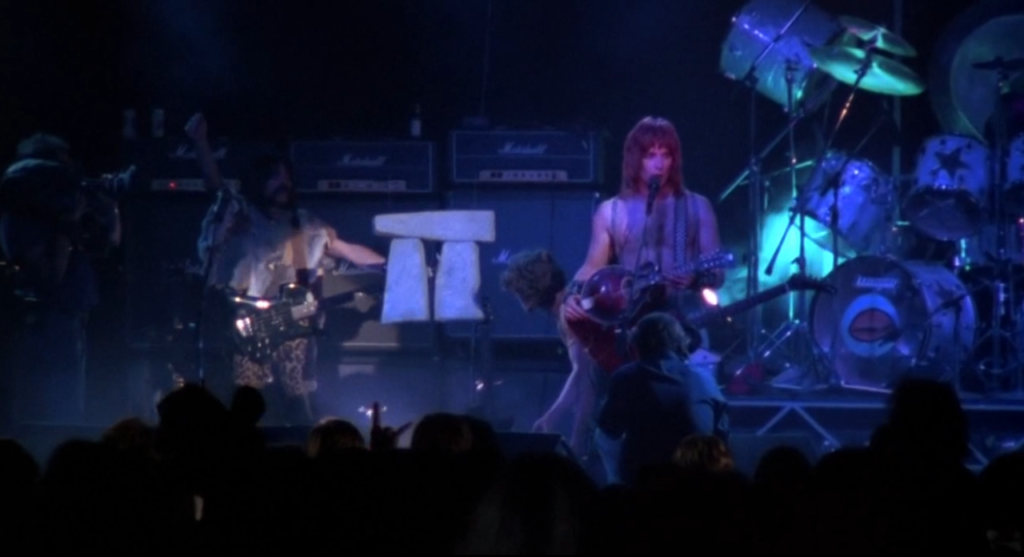
“It’s such a fine line between stupid and, uh…”
“Clever.”
“…Yeah.”
Which brings us, once more, to the somewhat less obvious movie musical stylings of This is Spinal Tap. For me, the essence of this mockumentary is encapsulated in that 3 or 4 second pause of pained silence where interviewer “Martin DiBergi” (Rob Reiner) informs lead guitarist “Nigel Tufnel’”(Christopher Guest) of a glaring error in his amp volume-reasoning. Tufnel, nonplussed, recovers and loftily proclaims that “THESE go to ELEVEN.” Sure, part of him must realize he’s saying something incredibly stupid, but he simply can’t help himself. He’s pompous and fatuous almost by default.
So much so that I gather that real rockers—from Van Halen to Aerosmith—simply didn’t get how the movie was funny at all when they first saw it. They just thought it was REAL.
From the incredibly detailed backstory of “one of the world’s loudest bands” to the incessantly passive-aggressive backchattering between the bandmembers, one can see how many thought Spinal Tapwas an actual band and that this was just another ‘rockumentary.’ But they weren’t and this wasn’t. In the “topsy-turvy world of rock n’ roll,” the actual rock comes almost as an afterthought when a self-important rocker can let loose with a long stream of pretentious blather. As the last in a long line of ill-fated drummers puts it (R.J. Parnell as “Mick Shrimpton”), “long as there’s, y’know, sex & drugs I can do without the…”
I think we all know the rest.
VII. TOPSY-TURVY (1999, UK, dir. Mike Leigh)
 The screen biography is usually considered the least reputable among classic film genres, while musical screen biographies are almost always danged near unwatchable. The handful of movies that bucked the latter trend—Yankee Doodle Dandy (1942) being the one true masterpiece of the genre—did so by avoiding some of the pitfalls inherent to the genre. Mainly, that whole ‘triumphing over adversity’ thing. Bad enough suffering through the various Stor[ies] of… Louis Pasteur, Emile Zola, Benjamin Disraeli et al. ‘overcoming great odds’ to achieve the lofty heights of ‘fame and recognition’; set that same story to the musical careers of Jerome Kern (1946’s Till the Clouds Roll By), Gus Kahn (1951’s I’ll See You in my Dreams), Fanny Brice (1968’s Funny Girl) et al. and you have a disjointed pseudo-epic padded out with a good 45 minutes of unimaginative musical numbers and a solid 2 hours of sleep-inducing ‘drama’.
The screen biography is usually considered the least reputable among classic film genres, while musical screen biographies are almost always danged near unwatchable. The handful of movies that bucked the latter trend—Yankee Doodle Dandy (1942) being the one true masterpiece of the genre—did so by avoiding some of the pitfalls inherent to the genre. Mainly, that whole ‘triumphing over adversity’ thing. Bad enough suffering through the various Stor[ies] of… Louis Pasteur, Emile Zola, Benjamin Disraeli et al. ‘overcoming great odds’ to achieve the lofty heights of ‘fame and recognition’; set that same story to the musical careers of Jerome Kern (1946’s Till the Clouds Roll By), Gus Kahn (1951’s I’ll See You in my Dreams), Fanny Brice (1968’s Funny Girl) et al. and you have a disjointed pseudo-epic padded out with a good 45 minutes of unimaginative musical numbers and a solid 2 hours of sleep-inducing ‘drama’.
BO-RING.

“There’s something inherently disappointing about success.”
Which is why my enthusiasm for a semi-obscure musical biography of Victorian theatre impresarios Gilbert & Sullivan—written and directed by a filmmaker, Mike Leigh, acclaimed for his unsparing depictions of British working class life (Life is Sweet [1990], Secrets and Lies [1996])—knows absolutely no bounds. Set during a period leading up to the creation of the pair’s most famous ‘comic opera’—The Mikado (1885)—the movie details the uneasy partnership of Messrs. Gilbert & Sullivan (Jim Broadbent, Allan Corduner), painstakingly delving into their troubled working relationship, their constant battles with management, their deft handling of overinflated egos—both on the production and performing ends—and their complicated personal lives. More than that, the film is an accurate and realistic recreation of “a little musical theatre on the River Thames”—The Savoy—and, by extension, the cross-section of late Victorian artists, performers, and businessmen who worked to make it great. It’s about theatre, art, and commerce, but more importantly it’s about the manners, mores, and attitudes that created a popular art form and, indeed, a cultural institution…
Also, it’s a lot of fun and, well, the music’s just great.
VIII. O BROTHER, WHERE ART THOU? (2000, Studio Canal/Working Title Films, dir(s). Joel & Ethan Coen)
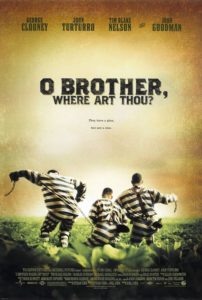 And so we come to the end of a long musical odyssey with a movie about, well, a long musicalOdyssey. (Homer by way of the Missisippi Delta, to be precise.) And for this one, folks, Ol’ Pappy O’Mory’s gonna be ascending the soapbox of curmudgeonly indignation to wield the cudgel of oldtime movie knowledge against the cinematic wasteland of today…
And so we come to the end of a long musical odyssey with a movie about, well, a long musicalOdyssey. (Homer by way of the Missisippi Delta, to be precise.) And for this one, folks, Ol’ Pappy O’Mory’s gonna be ascending the soapbox of curmudgeonly indignation to wield the cudgel of oldtime movie knowledge against the cinematic wasteland of today…
In 1941, comedy writer/director Preston Sturges made Sullivan’s Travels, a movie about a self-important comedy director named “Sullivan” (Joel McCrea) who wants to make a serious drama about the Depression called, O Brother, Where Art Thou? Through his experiences, Sullivan comes to see the error of his grandiose ideas and instead decides to put his talents to their best possible use in a world gone made with war, deprivation, and terror: making silly comedies. Nearly 60 years later, two of modern cinema’s most merry pranksters, the Coen Brothers, took Sturges up on the fictional Sullivan’s redraft for their own hilarious Depression-era hijinks. Laughter in the face of misery, as it were.
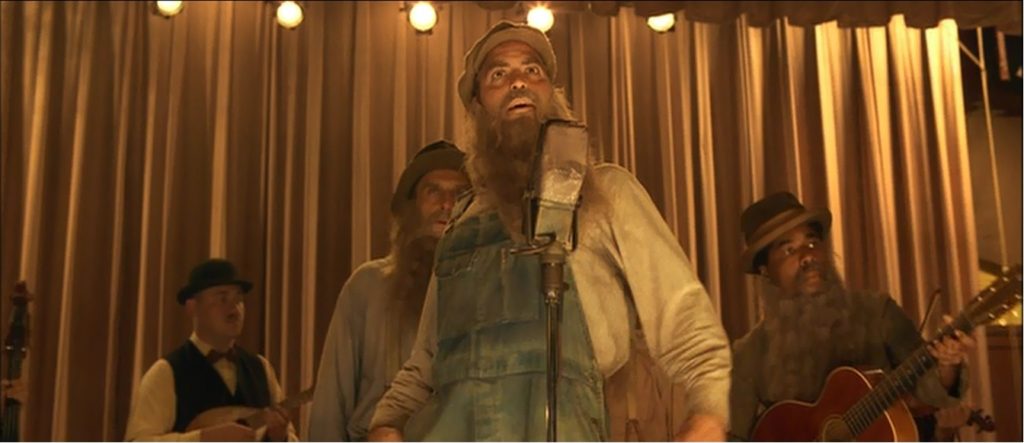
“I detect, like me, you’re endowed with the gift of gab.”
So what is it that the Coens do better than anyone else making popular movies today? Basically, they’re original. Sure, they draw on sources here as varied as The Three Stooges, ’30s social drama, old-time music, Southern politics, and classical literature (which, by the way, they claim never to have read), but their approach to that mirthful mélange is entirely their own.
In particular, their vision of the music and social culture of the Deep South during the Great Depression is both vivid and accurate. Where, in that distinctly American musical melting pot of the Mississippi Delta, you’ve got country, folk, gospel, blues, bluegrass, and traditional music existing side-by-side: bearing witness to a trio of little girls singing “In the Highways” at a town fair/reform political rally and a lone figure strumming “Tishimongo Blues” at a country crossroads after selling his soul to the devil, alongside the scented pomade of a peripatetic rogue possessing a self-described “gift of gab” and an obsession with the perfect “coiffure.”
Through some magical movie alchemy known only to The Brothers, it somehow all comes together to create something entirely unique. (Despite the merely physical fact of the Coens’ decidedly hirsute personal appearances, I think we can nonetheless assume that Joel and Ethan are, at heart, “Dapper Dan” men.)
From the sepia-toned imagery—an entirely correct and restrained usage of computer graphics, I should add—to the sounds of “mass-communicatin’”, this is movie-making at its finest.
Pretty darned good for a silly comedy.
Gotta Dance, Gotta Dance, Gotta Daaance

